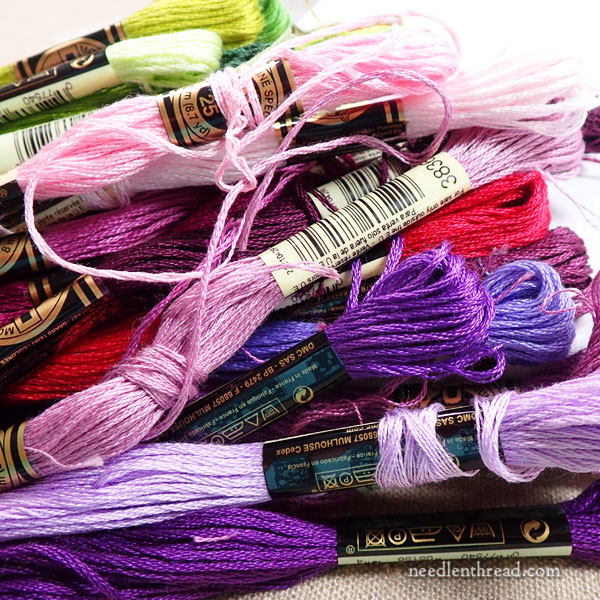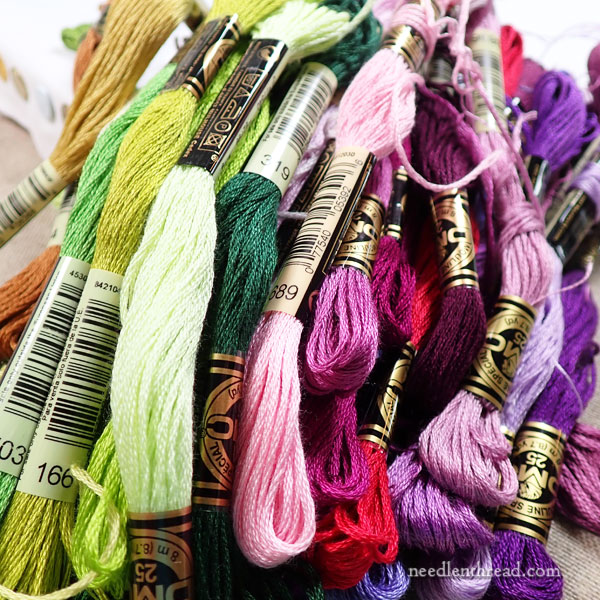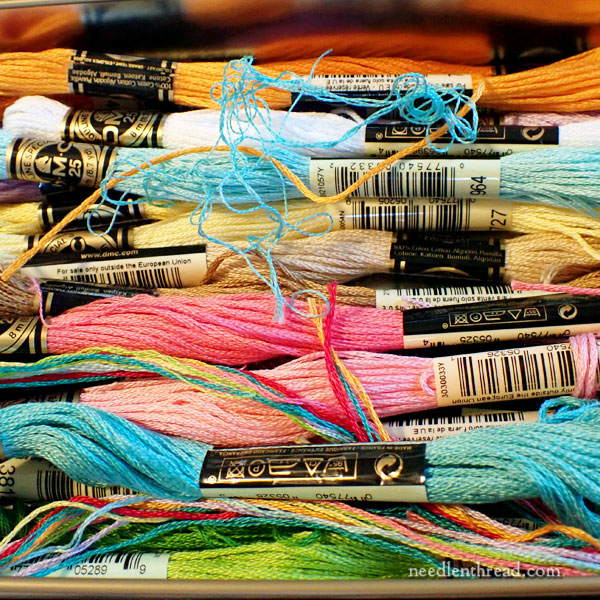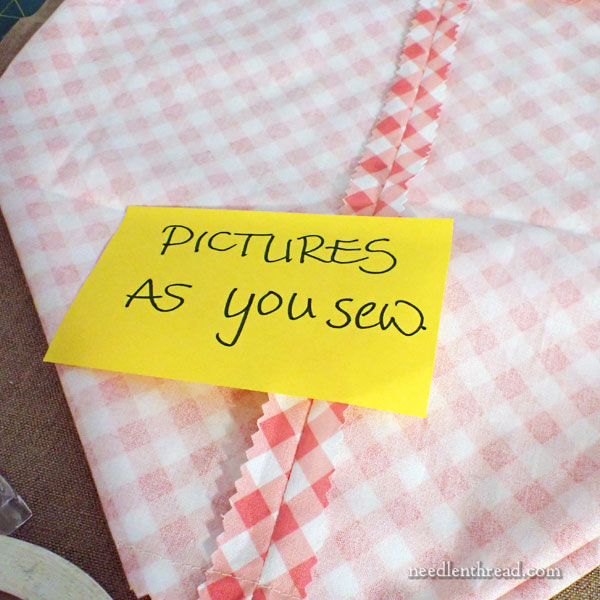It is the best of jobs. It is the worst of jobs.
Picking colors for embroidery projects can be great fun – but it can also be really hard!
Today,I’m going to sneak-peek the colors for the next tutorial series (I’ll let you guess what the subject matter is) and chat a bit about selecting colors and narrowing down a final color palette for an embroidery project… or at least, how I do it, for what it’s worth!
We’ll also discuss a few miscellaneous tips for project organization.

This seemingly-discombobulated mass of thread is more organized than it looks!
Or at least, it was, before I bunched them all up for the photo.
This is my current working color palette for the next tutorial in the How to Embroider (Blank) series that you can find here. So far, we’ve covered wheat, strawberries, daisies, and now I’m preparing the fourth project, represented by these colors.
Can you guess the subject matter of the fourth project?

It can sometimes be difficult and quite time consuming to choose colors for an embroidery project. For me, it never happens in one fell swoop. I don’t select colors and say “Here it is, the perfect color palette for that project, written in stone, never to change.”
From Design to Threads
I usually start with an idea, which morphs into a doodle, then a design, and then I play with colors on paper (or sometimes on my computer).
Normally, I’ll draw the design and attack it with colored pencils. If I’m planning on a lot of shading, I use Prismacolors because they blend nicely. Sometimes, I might use paint (watercolor or the like), but normally, my preferred color play tools are pencils.
Then, I pull out a color card to get an idea of what color families correspond to both the colored design and whatever is floating in my head. Having a real thread color card is super helpful at this point. (I wrote about those here.)
With a general idea of the color numbers that I’m shooting for, I go to my thread drawers. I store my threads in these cabinets that I wrote about here and here.
Each drawer has a specific type of thread in it (i.e., DMC stranded cotton, Au Ver a Soie Soie d’Alger, AVAS Soie de Paris, etc.) I don’t mix thread types within drawers.
The drawers of stranded cotton are arranged by color, so I have a couple drawers of DMC greens, a couple drawers of blues, etc.
Normally, I tackle greens first, if I design has a lot of green in it.
Greens are very abundant in almost every thread line. There are so many types and shades of green, that I find greens the most time consuming colors to figure out when working with pretty much any type of embroidery thread.
I’ll pull the green drawers, take them underneath good lighting, and start looking for the thread numbers that I noted from the color card. I’ll also pull any other greens that strike me pertinent for the design.
The Working Palette
Sometimes, I’ll end up with a dozen or more different greens and shades of greens – from yellow-greens to dusty greens, to pine green, to bright grass greens, and so forth.
I always start with more colors than necessary!
Once I have all the colors – in this case, purples, pinks, reds, some yellows, some browns, some almost-whites – together, I’ll weed some obvious colors that won’t work out. Sometimes, when all the colors are lined up, a few will immediately strike the eye as highly unlikely contenders!
At that point, I have a working palette.
It will not be my final palette. If I’m stitching just for myself, that’s one thing, but if I’m working a project that I’m going to share with you, I really don’t want to load you with a 40+ color palette when we can probably get away with a palette of 20 – or fewer! – colors.

(This is not the same project, just in case you’re wondering!)
Here’s a collection of threads I pulled for a much less complicated – but definitely more colorful! – summer embroidery project I’m working on at the same time.
This project is light, fun, impromptu. It doesn’t take as much planning, and the stitching decisions are a bit random.
I’m really just sharing the photo to show you what happens next with a collection of threads pulled for a project.
They go into some kind of tray – something more or less flat, so that I can see most of the colors the whole time, and so I can easily move it, arrange it, and keep everything together in one place.
As I stitch with different colors on a new project, I don’t pre-cut the threads. I use them straight off the skein, and any time I cut a thread and pull out a few strands, I usually will wind the leftover strands back around the skein so that I know exactly what skein it came from. This is especially important when working with similar shades of the same color.
If I’m working with a more diverse color palette (like this light and bright one directly above), I might not wind up every leftover thread on its original skein, since the colors are pretty obvious. But I keep them all in a flat tray, tin, box lid, or something similar, so that I can see them, reach easily for the colors I want, and so forth.
As I stitch on a larger and more intense project (like the first color palette’s associated project), I keep copious notes of what colors I’m using where on the design. I do this on a printed copy of the design, drawing arrows, or numbering elements and keeping a corresponding number list.
The Final Palette
When the project is finished, I go back through all the threads and I weed out the ones I did not use. Normally, I can weed out quite a few unused colors!
Then, I make this type of real-thread color card for that particular project, and stick it in my project book with the notes on the project.
And that’s how I choose and narrow down colors for an embroidery project.

This morning when I came into the studio, I was looking at my work table and contemplating today’s to-do list.
The project belonging to the second color palette above – let’s call it “Happy Camper” – is going to end up finished into something useful for summer.
As a bonus, I thought you might appreciate one of my pet organizational tips: sticky notes with reminders on them.
Never underestimate the power of the sticky note.
Have a magnificently jolly Monday!







This might be too obvious, but it jumped out of that pile of thread right into my face: “How To Embroider Lavender.” If I’m wrong, well, I’ve been wrong before. 🙂
Iris, Hydrangea or Lilac – I hope its all of them 🙂
Dear Mary
What a great way to organise threads, you have a wonderful selection of colours and different types of thread and silk all kept in those really useful cabinets, which are great for picking out colours threads. like you I have a real Soie d’Anger silk thread colour chart and it is lovely and useful because it shows the actual colour of the threads as opposed to a photo which don’t give the true picture of the threads. It’s nice to have a big space to store threads which you need in your business. I can’t guess what the next project will be unless it’s Lavender. Thank you for showing and sharing with us your thread colour and for the process of choosing thread colours, and for the photos and links.
Regards Anita Simmance
Hmmmm…. Nice colors!
I’m thinking something with vines. Maybe clematis?
Btw. I LOVE sticky notes and use them a lot! Drives my husband nuts though.
To me, these threads say tulips—beautiful tulips!
Lilacs!
Mmmmmmm – I love lilacs! But, alas, no. Not flowers!
As well as choosing a thread colour palette I spend a lot of time over which colour linen to use. I find just a subtle change can make quite a difference. I usually bunch my threads together and try against different linens. What do you suggest. Linen first or threads first?
I do the same – I generally start with a white background when I’m selecting threads, but then I try the threads on different backgrounds to see where they will look better. This particular set is going on white.
To me these colours sing sweet peas
Mary I have enjoyed stitching the strawberries and am well into the daisies I am learning so much thankyou for all the great instructions. My guess is the colours are to embroider Fuchsias.
I hope it’s irises!
que belleza Mary demasiados bellos
Hi Mary to me the colours look like pansies. Thanks for all your hard working in creating such a wonderful website
Dear Mary,
My guess is pansies. They always appear so bright and cheerful!
Thank you for your wonderful tips on the colour selection process…. my least favourite task in any project … and also in clothes to wear. Some just seem to have the knack of getting it right.
Look forward to following along on this next new project and to hearing what it is!
Kindest regards
Louisa
Maybe I was hungry but I was reminded of grapes? Still working on the daisies. Sidetracked by another deadline
Looks like pansies to me!
I see pansies….?
Sweet peas come to mind ….
I’m drawing a blank on what the plan is. Part of me says iris – but no blues are pulled out. Another says roses, but it seems like a lot of purples are in that pile. Coneflower – they come in all sorts of colors now, so maybe that’s it? Other commenters have made some guesses that would all be lovely also. Petunias! That’s my final guess – they come in all those colors and more.
Sticky notes are so useful. In the project kits, all around the computer screen and calendars, every room of the house, the car…
I’ll give you a hint: it’s not flowers at all! LOL!
Mary if it’s not flowers perhapes it’s Grapes.
This first thing that popped into mind when I saw those embroidery threads in the first picture above was…..cosmos one of my favorite flowers. Judie
Blackberries or raspberries?
I would love to subscribe to your newsletter and learn more about unusual stitches. I have been a stitcher a long time and do reproduction samplers but I am always ready to learn more.
Hi, Holly! Thanks, and welcome aboard! You’ll find the sign-up for the newsletter in the left column of my website, if you’re on a computer. If you’re on a mobile device, you’ll find the sign up under the main menu (it’s the three-lined “hamburger” in the top right corner). Just scroll down to the email newsletter “form” where you enter your email address. You’ll have to look for the confirmation email in your inbox, and click the confirmation link to make sure you’ve opted in to receive the newsletter. You may have to check your spam filter, or add my email address to your contacts or “approved” list, to make sure they don’t get filtered. Hope that helps!